By Celia Burke ’14
Double Major in Anthropology and War and Peace Studies
My plane landed on the runway of the Dublin International Airport on June 26, exactly 50 years (give or take a few hours) after John F. Kennedy arrived in Dublin for his first, and only, presidential trip to Ireland. President Kennedy stated during his visit in 1963 that Ireland “is not the land of my birth, but it is the land for which I hold the greatest affection, and I will certainly come back in the springtime.” The president could not fulfill this pledge, as he was assassinated that November.
Like President Kennedy, I am the great-grandchild of Irish immigrants. During my time in Ireland, however, I visited no ancestral birthplaces, nor did I search for long-lost relatives. Unlike many tourists, I was not in Ireland to dig into its ancient history, stare at ruins, or listen to folk music in pubs. In fact, the vast majority of my time in Ireland was spent in the United Kingdom, and the historical events I learned about were from the recent past–as recent as 2010.
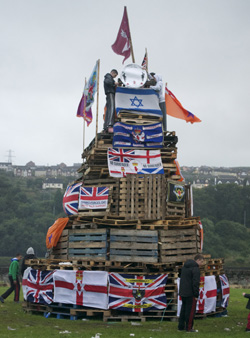
A bonfire built by some members of the republican community. Bonfires are very common in the summer, but most are built by loyalists to commemorate events like the Battle of the Boyne. They are politically charged events, as evidenced by the number of British flags and other symbols of unionism to be burned (loyalists burn nationalist symbols, such as the Irish tricolor).
I spent eight weeks in Derry, Northern Ireland. This city has been populated since at least the 6th century C.E. It is situated on the River Foyle, close to the northern coast of Ireland. While I was there, I performed field research for my senior thesis on community-based “post-conflict” memory and history projects in a couple of neighborhoods in Derry. I spent a lot of time sitting in museums and photo exhibits about “The Troubles,” talking to local men and women who create or coordinate these projects, and taking photos of murals and local monuments and events (I was “that girl” that constantly blocks your view of the stage by holding her camera up, nudges you out of the way to get in a street performer’s face, and won’t stop asking questions that can at best be described as inane).
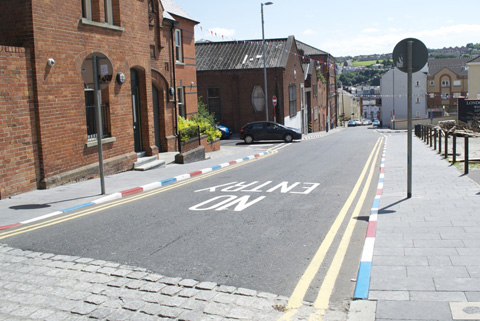
Painted curbs in the Fountain, a unionist neighborhood in Derry. The red, white and blue marks on curbs are a sign that this is a unionist area (in nationalist areas, they would be painted green, white and orange). Many curbs are no longer painted.
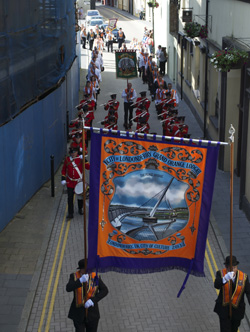
The Orange Order, a unionist organization, marches in preparation for a large march on the 12th of July. The banner for the City of Londonderry lodge depicts the Peace Bridge, a pedestrian bridge built to connect the ‘Waterside’ and ‘Cityside’ areas of the city.
When I decided to spend my summer exploring such dark topics as how people present their collective history of trauma to one another and the world, it came as no shock to many of my friends. They are used to seeing me rummage through a backpack (over)filled with books on political violence, state oppression, justice, and culture. I hope to build my career studying these concepts. I am particularly interested in how violent state oppression is written into the law and “official” state narratives, and in how communities that are marginalized or actively targeted by the state respond to everyday injustice and oppression. Many of the official accounts of events that took place in Northern Ireland during “The Troubles” are currently disputed, or have been proven to be untrue. The community histories and memory projects built by Derry men and women protest against the dominant narratives that misrepresent their lives, struggles, and aspirations. They are powerful political statements in an area in which understandings of the past play a key role in how people interpret current events and envision the future.
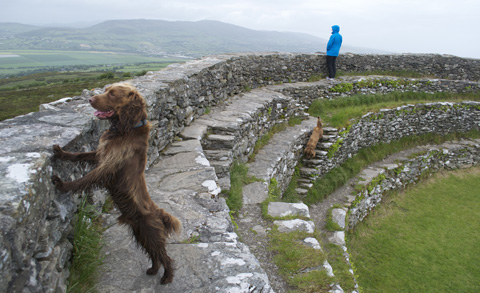
An Irish field spaniel (named Buttons) takes in the view from the Grianán Ailigh, a ringfort in the Inishowen peninsula of County Donegal. The fort was originally built in about the 6th or 7th century CE. It was heavily restored in the 19th century, and is now a National Monument (of the Republic of Ireland, where it is located).
Even though I didn’t set out to learn about Ireland’s prehistory, it’s difficult to spend time on the island without being exposed to at least some remnants of the people whose ancient monoliths and forts still stand in farm fields, integrated into the daily lives of the families that till the land. I gained insight into my ancestors, as well. A few of the bedtime stories and folk tales that my parents and grandparents told me as a child were stories passed down to them from their Irish parents and grandparents. I wish I could say that I, as an imaginative child, believed wholeheartedly that these stories were true and that going to Ireland allowed me to dip back into these moments of wonder. Unfortunately, for this essay and I’m sure for my parents, I enjoyed these stories without ever believing that they could be true (1). Back in March, when I was in Northern Ireland on an OU study abroad course Human Rights, Law, and Justice in Northern Ireland, we visited a couple of areas on the coast. Because of the (notorious) Irish weather, the rocky beaches and high cliffs overlooking the ocean faded into mist all around me. It was as if the tangible world dissolved about a hundred yards away – the ocean and sky blended into one another, blocking out the horizon. I suddenly understood the stories about how a world of mythical beings coexists with our own, just out of reach (maybe it was the jetlag).
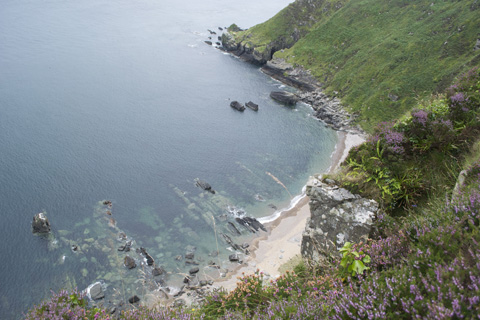
A view of the coast from one of the northernmost points of the island of Ireland, in the Inishowen peninsula.
This summer, I got to be in Derry during the Fleadh Cheoil na hÉireann—the biggest traditional music festival in Ireland (2), and break a world record. I made friends who were great craic (3), learned how to (as a pedestrian) navigate traffic that drove on the left side of the street (4), and traveled through a bit of the (gorgeous) coast of Donegal. Independent field research was an enlightening, frustrating, emotionally difficult, life-affirming process. Since I was alone, I was forced to learn to be assertive, adapt quickly to change, and be patient. I learned better how to critically analyze the world around me, as well as my inner thoughts and assumptions. You know, that “summer vacation” stuff.
(1) In my quest to be the Most Frustrating Child Ever, I never believed in Santa Claus. I’m not kidding. This was my father’s favorite Holiday Party Fun Fact/Complaint for, probably, my entire childhood.
(2) Okay, so maybe I was there a little bit to listen to folk music in pubs.
(3) A word meaning “fun,” “good conversation” or “a good time” in this context, but “news” or “whatever’s currently going on” in other contexts. A common greeting amongst the people I spoke to was, “what’s the craic?” which has just about the same ambiguous (but mutually understood) meaning as our “what’s up?” in the United States.
(4) Ha ha! I’ve fooled you. I never mastered crossing the street, and now that I’ve been back in the United States for five weeks I…still haven’t re-mastered being an American pedestrian. I can honestly say that most of the time I have no idea what direction cars are supposed to be driving in.
About the Author: Celia Burke is a double major in Anthropology and War and Peace Studies. Her research in Northern Ireland was made possible through partial funding from University College.



















Comments